(!)Due to
Microsoft's end of support for Internet Explorer 11 on 15/06/2022, this site does not support the recommended
environment.
Instead, please kindly use other browsers like Google Chrome, Microsoft Edge or Mozilla
Firefox.
- Notice of End of Sales for Economy Series Pneumatic Equipment Category. More details.
Types and Features of Wrenches
Double-ended wrench
This is a tool used for tightening and removing bolts and nuts.
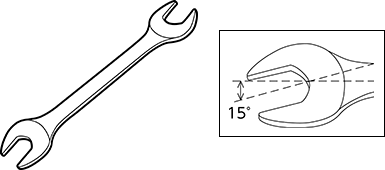
Features
- Tightens and loosens by holding two faces (two parallel faces) of a bolt or nut. The head shape may be round or pointed, with the pointed type having a thinner tip than the round type, making it easier to use in tight spaces.
- The open mouth allows fast turning at temporary tightening.
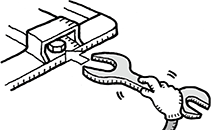
Table of bolt thread diameter and wrench width across flats
| Metric thread | Hex bolt/nut mm | Compact hex bolt/nut mm | High-strength hex bolt/nut mm |
|---|---|---|---|
| M1.6 | 3.2 | ||
| M2 | 4 | ||
| M2.2 | 4.5 | ||
| M2.5 | 5 | ||
| M3 | 5.5 | ||
| M3.5 | 6 | ||
| M4 | 7 | ||
| M4.5 | 8 | ||
| M5 | 8 | ||
| M6 | 10 | ||
| M7 | 11 | ||
| M8 | 13(14) | 12 | |
| M10 | 16(17) | 14 | |
| M12 | 18(19) | 17 | 22 |
| M14 | 21(22) | 19(21) | |
| M16 | 24(26) | 22(23) | 27 |
| M18 | 27(29) | 24(26) | |
| M20 | 30(32) | 27(29) | 32 |
| M22 | 32(35) | 30(32) | 36 |
| M24 | 36(38) | 32(35) | 41 |
| M27 | 41 | 36 | 46 |
| M30 | 46 | 41 | 50 |
| M33 | 50 | 46 | |
| M36 | 55(54) | 50 | |
| M39 | 60(58) | 55 | |
| M42 | 65(63) | ||
| M45 | 70(67) | ||
| M48 | 75(71) | ||
| M52 | 80(77) | ||
| M56 | 85 |
(Old JIS indications in parentheses)
Type and class
| Type | Class | Symbol indicating class | |
|---|---|---|---|
| Type according to head shape | Type according to number of openings | ||
|
Round shape 
|
Single ended | Normal | N |
| Heavy-duty | H | ||
| Double ended | Normal | N | |
| Heavy-duty | H | ||
|
Pointed 
|
Single ended | - | S |
Single-end open-end wrench

Features
- This type has an opening only on one end.
Combination wrench

Features
- This is a two-in-one functional tool that is easy to use even at home for a wide range of repairs and crafts. The open-end can be used for temporary tightening, and the box wrench can be used for final tightening.
Main points
-
Check the width across flats (mm) of the bolt/nut and select a wrench of the corresponding
size.

- Select the type that best suits the application. (Single ended, double ended, combination, etc.)
Spanner wrench (hook wrench)
With this tool, the claw is inserted into a groove or pin hole and the principle of leverage is used to tighten.
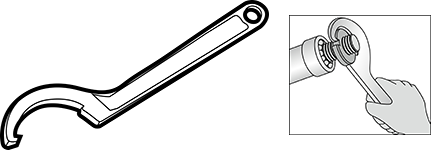
Two points of contact are at the hook at the tip and at the base, and the principle of
leverage
is used to tighten.
If the diameter is smaller than the applicable range of the wrench, the claw cannot hook. If
the
diameter is large, the wrench can easily come off, which is dangerous.

Features
- Used for installation and removal of round nuts and nuts with bearings. Force can easily be applied by turning while contacting the nut at the two points (hook at tip and base).
Adjustable spanner wrench
Hook type
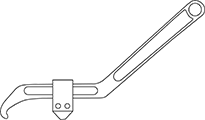
Pin type
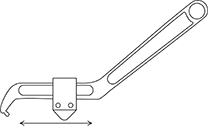
Features
- Moving the slide enables the tool to accommodate a wider range of diameters.
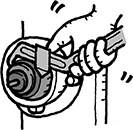
Hook pin wrench
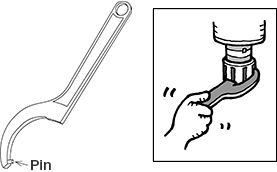
Features
- Force can easily be applied by turning while contacting the nut at the two points (pin at tip and base).
- Used when the part to receive a round nut (shape where force is applied) is a round hole.
Main points
-
Check the shape of the claw (hook or pinhole type).
* The shape of the claw (hook or pin hole) must match the shape of the groove or hole where force is applied on the round nut or the wrench will not be usable. - Check if the diameter of the object to be tightened is within the wrench’s range of use.